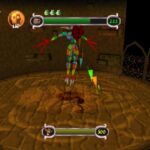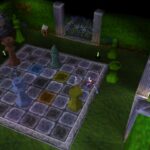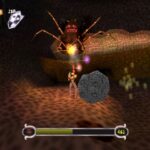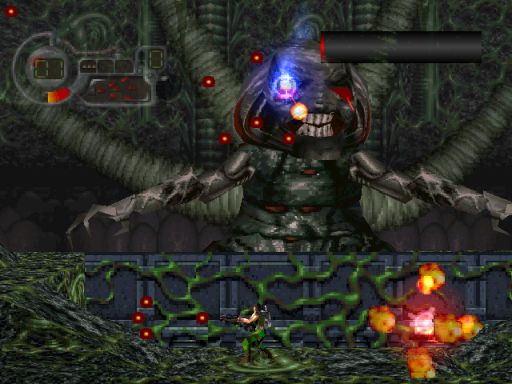Developer: Sony Cambridge Publisher: Sony Released: 10/01/98 Genre: Action
The PlayStation built a reputation as the home for third party games during its generation. And while every developer on Earth supported the platform Sony were not known as an especially strong first party. Psygnosis carried them in the early years as well as their smart localization choices. But they would build a solid stable of creators in short order. Medievil was one of the surprise favorites at E3 1997 and would firmly establish Sony Cambridge as a solid team. Medievil is a great game and one of my favorite titles on the system.
Sir Dan Fortesque is the hero of Gallowmere, having beaten the evil wizard Zarok and saving the kingdom in the past. At least that is how the story is told. In reality it is all a lie as Dan was the first to fall in battle. 100 years have passed and Zarok returns and casts a spell to reanimate the dead and unwittingly reanimates Dan. With a second chance at life Sir Dan Fortesque sets out to be the hero everyone believes him to be and redeems himself.
As a 3d action adventure it is easy to make comparisons to Ghosts ‘n Goblins. However the only thing the two games share in common is its undead theme. Medievil is a melting pot of genres, with platforming like Super Mario 64, action like Capcom’s aforementioned title and even some light puzzle solving. Dan is a gangly mess as he moves about and his animations take full advantage of the fact he is a living skeleton. When you charge your sword he fully rotates his body for a 360 swing. With no weapon equipped he uses his arm instead. There is a large range of weaponry available from different swords and bows, to spears, shields, and even lightning. How you acquire most of this is unique to Medievil.
Every level has a Chalice of Souls that fills with every enemy killed. Filling it to 100% and finding it in each stage grants access to the Hall of Heroes where champions from the past will give you their gear. It sounds simple but doing so is an adventure in itself in every stage. The chalice is well hidden in every level and will often require some measure of backtracking to acquire. A few levels like the Sleeping Village start with it partially full and challenge you to avoid screwing up. While it may sound like mandatory the game does a decent job of providing just enough basic weaponry to manage although the journey will be harder. Trying to fill the chalice gives incentive to explore every nook and cranny in each stage but you would have done so anyway as the level design is generally excellent.
Medievil’s greatest strength is the variety in goals for every level. Very few stages are straightforward and most task you with helping NPCs or solving some puzzle first. Sometimes you will have to collect lost souls to buy passage to the next level. The Asylum Grounds presents five riddles you must solve to progress. My personal favorite comes second to last, a surprisingly modern city that sees you manipulating time to uncover its secrets. The dry British humor also lends to the game’s atmosphere. For a game this long to have so much variety is astonishing. And that extends to the setting as well. The game makes use of its undead theme to visit a diverse array of settings, from a creepy asylum, a ghost ship, a hedge maze and even a haunted pumpkin patch.
The one fly in the ointment would be the camera and to an extent the controls. Medievil was one of the first games to support the dual analog controller. The analog stick makes movement easier but Dan’s weird animations and sense of weight can make the control feel sluggish. There is no lock-on for combat so combat routinely devolves into a button mashing mess. But the biggest offender is the camera. You cannot manipulate the camera and it regularly chooses the worst angle for platforming or even simply walking around. It is manageable but I would be lying if I didn’t say it was frequently aggravating. You will blow through your life bottles in short order unfortunately.
Medievil is a long adventure at around twenty stages. For the most part you can complete each level relatively quickly and leave. But for completionists there are secrets abounds, from optional sub quests to extra items like life bottles. Filling the chalice in each level is optional but doing so is worth it for the equipment upgrades. Doing so becomes more of a challenge as you progress and to see the true ending you will need to do so in every stage. That is a tall order but the secret ending is worth it as it is a fun dragon to chase. There is a gradual difficulty curve and while the game may seem generous with refilling your life bottles it progressively leaves you to your devices. This is not an easy one and will require some time to see all it has to offer.
In Closing
Medievil is one of Sony’s best games for the PlayStation and a great action title in general. It has some warts like most games from that era do but they do not detract from the fun and variety it has to offer. Fantastic art direction and varied gameplay make this a great addition to the PlayStation library.











